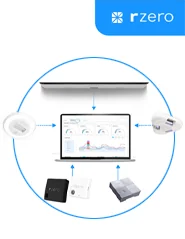
BACnet Gateway Explainer
Overview: Real-Time Occupancy Intelligence That Drives Energy Savings
The R-Zero BACnet Gateway enables real-time HVAC optimization by translating sensor-level occupancy data into actionable building control signals—directly within your existing BMS. This is the key enabler of our “data-only” optimization strategy, delivering energy savings with no construction, no IT headaches, and no disruption to tenant comfort.
How It Works
1. Sensor Data Ingested at the Edge
R-Zero smart sensors detect presence and movement across your space. This data flows to the R-Zero Gateway, a secure, networked edge device installed onsite.
2. Occupancy Logic Applied in the Gateway
Using built-in R-Zero logic, the Gateway aggregates data by HVAC zone—generating a binary occupancy signal(occupied/unoccupied) and/or occupant count per zone in real time..
3. Data Published to BACnet
The Gateway posts occupancy signals to your BACnet/IP network continuously, creating virtual BACnet points that mirror real-time zone occupancy.
4. HVAC Control Adjustments via BMS
Your building automation system (BAS) reads the occupancy signals from BACnet and adjusts ventilation and temperature setpoints accordingly—based on your existing control sequences and operational strategies.
Configurable to Your Building’s Need
The Gateway includes built-in configuration software, enabling your team or contractor to:
- Define zones and map sensors to HVAC zones
- Select between binary occupancy or occupant count
- Customize BACnet point names
- Manage and validate zone configurations over time
This allows the system to scale easily across diverse building types without requiring complex reprogramming of building controls.
Why It Matters
🔧 Simple Integration
- Seamless BACnet/IP output for plug-and-play compatibility with nearly any BMS
- No rip-and-replace or heavy retrofit needed
💡 Smart HVAC Adjustments
- Enables strategies like temperature setbacks, demand-controlled ventilation, and reduced airflow in unoccupied zones
- Adapts dynamically to real-time occupancy, not static schedules
⚡ Energy Savings with Zero Disruption
- Helps reduce HVAC energy use by up to 30%, aligned with our core value proposition
- Maintains tenant comfort and meets IAQ standards—validated by R-Zero sensors
🔐 Future-Proof & Scalable
- Supports MQTT, HTTP, and custom outputs for future integrations
- Can be layered with additional strategies (like temperature or airflow resets) as needed
Who Benefits
- Facilities Leaders cut HVAC costs without capex or disruption
- Property Managers deliver efficient, comfortable spaces with fewer complaints
- Energy & Sustainability Teams get verified impact on decarbonization goals
- IT & Compliance see minimal network footprint with full data security
More posts you might like
-

How to Pilot SecureAire Filters
A Step-by-Step Guide for Facilities Teams Cut HVAC energy use, extend filter life, and improve indoor air quality—without disrupting operations. Piloting R-Zero’s SecureAire filters is a smart move for facilities teams seeking to enhance HVAC performance and air quality while achieving energy savings. This guide walks you through how to plan and execute a data-driven […]
-

Smarter ventilation, lower cost: a guide to reducing HVAC energy without disruption
This guide is for energy leads and operations teams evaluating R-Zero. It outlines how our platform delivers measurable HVAC energy savings—not through expensive capital upgrades or disruptive equipment replacements, but by intelligently reducing airflow where it’s not needed and improving the efficiency of air movement through smarter filtration. Static schedules vs CO₂ vs occupancy-driven control […]
-

The Energy Efficiency FAQ: Clear Answers to Common Questions About Smarter Buildings
When people first learn about R-Zero’s platform, they often have smart, valid questions, and a few common concerns. Some are based on past experiences with other systems. Others come from how building operations used to work. This FAQ is here to give you clear, straightforward answers. Just helpful context on how R-Zero fits into your […]

